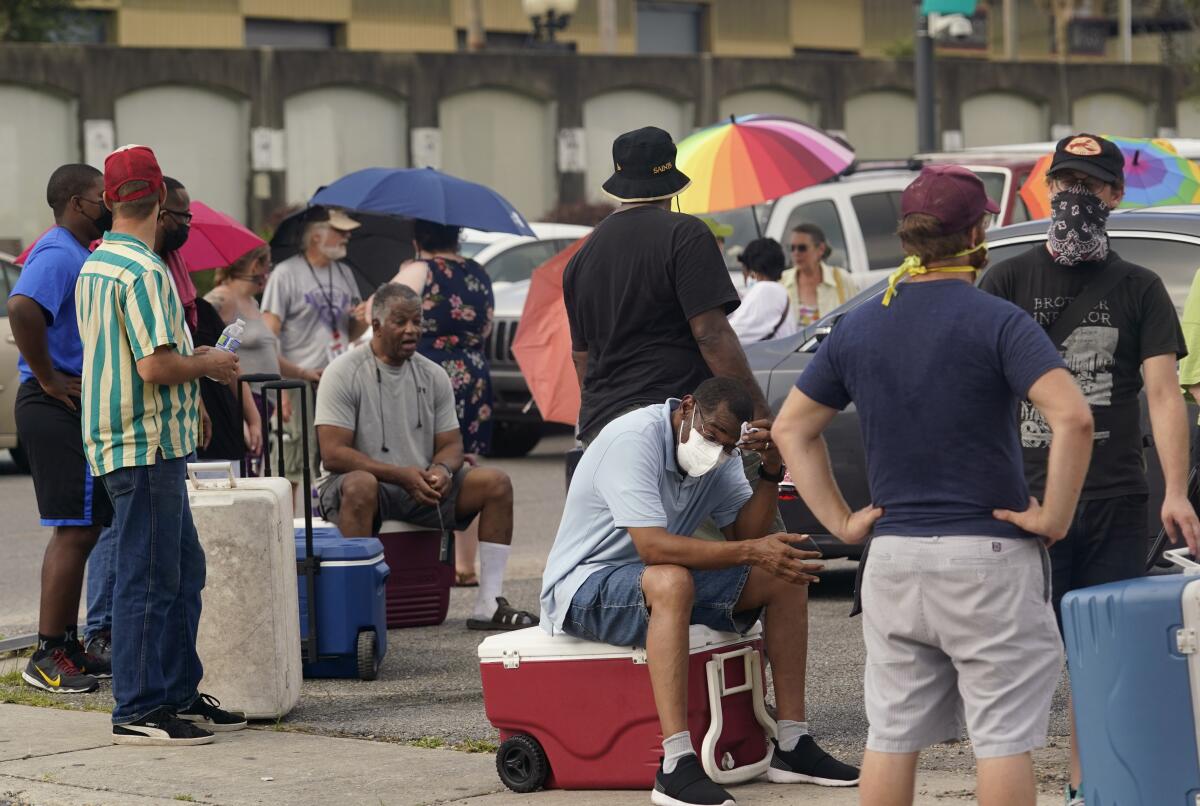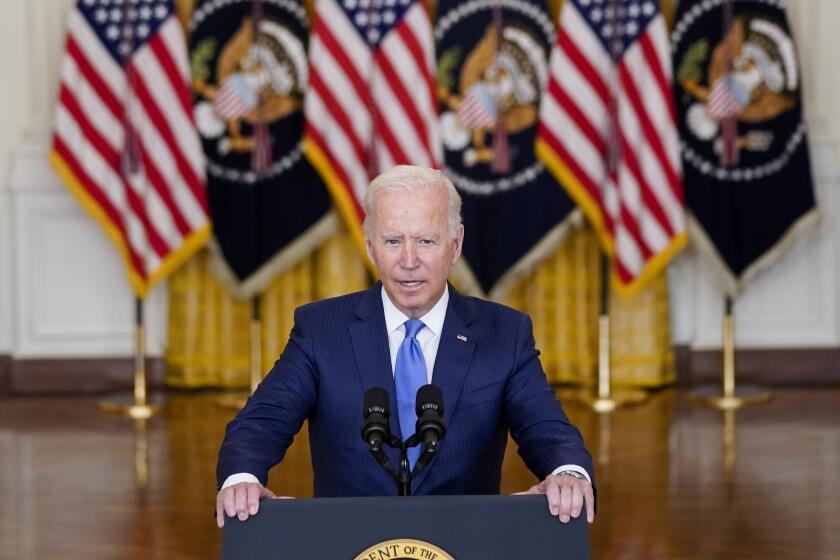Biden administration announces plans to protect workers, communities from extreme heat

- Share via
WASHINGTON — The Biden administration is moving to protect workers and communities from extreme heat after a dangerously hot summer that spurred an onslaught of drought-worsened wildfires and caused hundreds of deaths from the Pacific Northwest to hurricane-ravaged Louisiana.
Under a plan announced Monday, the departments of Labor and of Health and Human Services as well as other federal agencies are launching actions intended to reduce heat-related illness and protect public health, including a proposed workplace heat standard.
White House climate advisor Gina McCarthy called heat stress a “silent killer” that disproportionately affects poor, elderly and minority groups. Though not as dramatic as wildfires or hurricanes, “heat stress is a significant, real threat that has deadly consequences,″ McCarthy said in an interview.
“Many people don’t recognize that heat stress is a real physical problem until it’s too late for them,” she said.
The effort to address heat stress comes as President Biden is working with world leaders to hammer out next steps against rapidly worsening climate change. Biden on Friday announced a pledge with the European Union to cut climate-wrecking methane leaks, and he is expected to address climate change when he goes to the United Nations on Tuesday.
President Biden visited a firefighting headquarters in Idaho before he’s expected to tour wildfire damage near Sacramento.
A June heat wave in the Pacific Northwest, exacerbated by climate change, caused hundreds of deaths and thousands of emergency room visits for heat-related illnesses. In Louisiana, more than a million people, including the entire city of New Orleans, lost power when Hurricane Ida struck Aug. 29. At least 12 of the 28 Ida-related deaths in Louisiana were caused by heat, according to the Louisiana Health Department.
As part of the administration’s plan, the Labor Department is launching a program to protect outdoor workers, including agricultural, construction and delivery workers, as well as those working indoors in warehouses, factories and kitchens. Farm and construction workers are at greatest risk of heat stroke and other problems, the White House said, but other workers lacking climate-controlled environments also face risks.
“Rising temperatures pose an imminent threat to millions of American workers exposed to the elements, to kids in schools without air conditioning, to seniors in nursing homes without cooling resources, and particularly to disadvantaged communities,” Biden said in a statement.
“As with other weather events, extreme heat is gaining in frequency and ferocity due to climate change, threatening communities across the country,” Biden added, citing National Weather Service data showing that extreme heat is now the leading weather-related killer in America.
The Labor Department’s Occupational Safety and Health Administration is set to issue a new rule on heat illness prevention in outdoor and indoor work settings and will focus interventions and workplace inspections on days when the heat index exceeds 80 degrees. The White House called the rule a significant step toward a federal heat standard in U.S. workplaces and said officials will expand the scope of scheduled and unscheduled inspections to address heat-related hazards.
The administration also will expand its Low Income Home Energy Assistance Program, or LIHEAP, to add programs to address extreme heat, the White House said. The program traditionally focuses on providing heat during winter weather but will be expanded to help with purchasing air conditioning units or paying electric bills for cooling assistance.
The president hosted virtual talks this morning with the aim of pressing for emissions cuts.
The administration is expanding the use of schools and other public buildings as cooling centers, a program McCarthy called lifesaving. “They are opportunities for people in every community to actually find relief at a time when they need it most,” she said.
McCarthy urged communities to implement programs such as “adopt a senior citizen” to conduct wellness checks, making sure that elderly residents are drinking fluids and not overheating. “That kind of personal touch is going to be the difference between an individual living longer and those that are passing away, basically unrecognized in their own homes,” McCarthy said.
David Hondula, an associate professor Arizona State University’s Urban Climate Research Center, said heat-related deaths are underreported nationwide and frequently occur in isolation, with “people who are literally alone.″ He applauded the Biden initiative but said more data are needed about health risks posed by extreme heat.
“Better tracking of heat-health impacts across the country can help us make smart investments,” Hondula said. More frequent inspections and safety checks at work sites — especially in agriculture and construction — will save lives, he said, adding that a proposed workplace heat standard “could be quite consequential for how work happens in the United States.″
The Biden administration has taken steps since its first days in office to tackle climate change. Extreme weather events across the country — from wildfires in California to Hurricane Ida and related floods that killed scores of people from Louisiana to New York — “have blown apart the lives of working families, wiping homes and businesses off the map,″ Biden said.
“This is a blinking code red for our nation,″ he added. “We cannot wait to act to meet the broader crisis of climate change.″
The situation is dire, but there’s hope: We can still prevent the worst devastation by slashing carbon emissions over the next decade.
As part of the new effort, the administration is focusing on urban “heat islands” where temperatures in cities with fewer trees and higher pavement concentrations can be higher than in surrounding areas. The administration will expand urban forestry programs and other “greening” projects to reduce extreme temperatures and heat exposure, the White House said.
The Department of Homeland Security, meanwhile, is launching a series of prize competitions focused on strengthening the nation’s resilience to climate change, including one on ways to protect people at risk of heat-related illness or death.
Public Citizen, a watchdog and consumer advocacy group, said federal action on heat stress is long overdue. The proposed workplace heat standard is especially important, said Juley Fulcher, a worker health and safety advocate. “Black and brown communities, especially farmworkers, are disproportionately subjected to work in extreme heat resulting in more heat stress illnesses, injuries and death,″ she said.
Marc Freedman, vice president of workplace policy at the U.S. Chamber of Commerce, called heat a “very challenging hazard to regulate, since there is no common threshold of risk and employees react differently to exposure.″
The chamber will work with OSHA in the rulemaking process, Freedman said. Such regulations typically take years to complete.
More to Read
Sign up for Essential California
The most important California stories and recommendations in your inbox every morning.
You may occasionally receive promotional content from the Los Angeles Times.
















